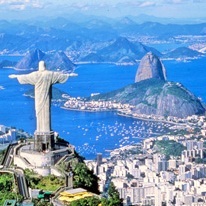Studies in Human Geography of Brazil are concerned with analyzing the demographic, economic, urban, rural, cultural, political and social elements of the Brazilian geographic space. In this way, both the elements that are intrinsically linked to the constitution of the national territory and the aspects of the interrelationship between Brazil and the world are analyzed.
In its human aspects, Brazil has a wide diversity, which is manifested in elements such as the ethnic disposition, productive levels, cultural and religious variations, among countless others aspects. Therefore, knowing more about the Brazilian space is to expand knowledge about this variety of interrelationships that build the country's identity and general vision.
Economically, Brazil has a solid structure, with the seventh largest GDP in the world, but it needs to advance in relation to the fight to income inequality and misery and poverty, even though the country has shown improvements in this field over the last few decades. Despite the heavy weight of agricultural production, the Brazilian space is quite industrialized, with a concentration of the secondary sector in the Southeast region, although there is a process of industrial deconcentration ongoing.
Brazil's demography has a high population quantity, enough to surpass the 200 million inhabitants mark. On the other hand, population density is low and population is poorly distributed across the territory. While the Southeast region has most of the population, the North region contains true “demographic gaps”.
Do not stop now... There's more after the advertising ;)
The Brazilian transport network is basically built around highways, which serve more than 60% of cargo transport in the country and are followed by railroads and waterways, although the last two mentioned types are more recommended in a country like Brazil, with a large territorial extension and a large number of rivers navigable.
The national agricultural production, throughout history, has always been based on large monocultures: initially, sugarcane predominated, the main product of the colonial sugarcane economy; in the 19th century, coffee production reached its peak; throughout the 20th century it was the turn of soy and, currently, there is a growth of sugar cane alongside soy itself. Despite this, Brazilian agricultural production is considered highly diversified in its current period.
In this section of Human Geography of Brazil, you will be able to deepen your studies about space Brazilian geographic area, better understanding its economic, cultural, structural, social and demographics. We hope to assist in studies on the various elements that make up the diversity of the national territory.
Good reading!
By Rodolfo Alves Pena
Graduated in Geography
The Brazilian agrarian economic development has permeated the wide installation of several monocultures throughout the territory. The predominance of one product or another has varied throughout history due to different international circumstances, given that this type of production has always been geared towards exports.
Among the different cultures that have predominated in the agrarian milieu and in the Brazilian economy throughout history, the following are not included:
“The industrialization of a society (…) always produces profound changes in geographic space, making it more urbanized and integrated, in addition to deepening the division of labor between the countryside and the City. The industrialization of Brazil – that is, the change from a rural and agrarian society to an urban and industrial one – began at the end of the 19th century, having intensified from the 1930s onwards”.
(VESENTINI, J. W. Geography: the world in transition. São Paulo: Editora Ática, 2012. p.553)
a) it was a late process, that is, carried out hundreds of years after the development of the countries where the I Industrial Revolution took place.
b) there was a gradual transition from handicraft to manufacturing to the mechanization of production.
c) is currently considered homogeneous and covers the entire national territory.
d) was responsible for the concentration of investments, becoming the main sector that generates jobs today.

